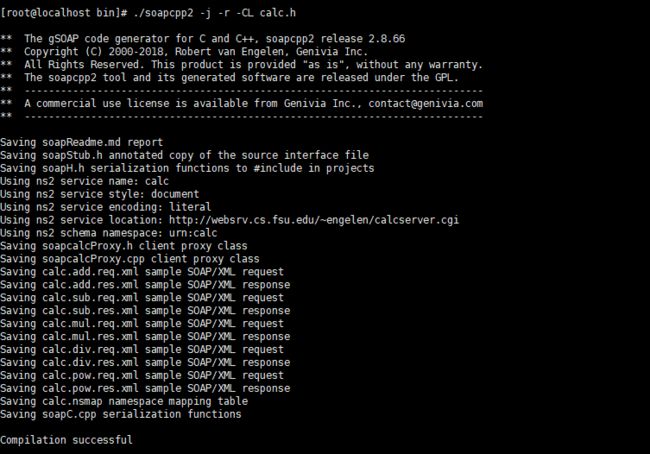2019独角兽企业重金招聘Python工程师标准>>> ![]()
工具:gsoap-2.8.66(这个是目前各个公司使用最多的,也是最完善的)
系统环境:Centos7 64位
步骤:
1.手动编写calc.h文件
//gsoap ns service name: calc Simple calculator service described at https://www.genivia.com/dev.html
//gsoap ns service protocol: SOAP
//gsoap ns service style: rpc
//gsoap ns service encoding: encoded
//gsoap ns service namespace: http://localhost/calc.wsdl
//gsoap ns service location: http://localhost/calcserver.cgi
//gsoap ns schema namespace: urn:calc
//gsoap ns service method: add Sums two values
int ns__add(double a, double b, double &result);
//gsoap ns service method: sub Subtracts two values
int ns__sub(double a, double b, double &result);
//gsoap ns service method: mul Multiplies two values
int ns__mul(double a, double b, double &result);
//gsoap ns service method: div Divides two values
int ns__div(double a, double b, double &result);
//gsoap ns service method: pow Raises a to b
int ns__pow(double a, double b, double &result);2.使用soapcpp2工具生成客户端所需文件(执行命令之前先删除上一个教程所生成的文件):
./soapcpp2 -j -r -CL calc.h
3.编写calcclient.cpp客户端代码:
#include "soapcalcProxy.h"
#include "calc.nsmap"
/* the Web service endpoint URL */
const char server[] = "http://localhost:8080";
int main(int argc, char **argv)
{
if (argc < 4)
{
fprintf(stderr, "Usage: [add|sub|mul|div|pow] num num\n");
exit(0);
}
calcProxy calc(server);
double a, b, result;
a = strtod(argv[2], NULL);
b = strtod(argv[3], NULL);
switch (*argv[1])
{
case 'a':
calc.add(a, b, result);
break;
case 's':
calc.sub(a, b, result);
break;
case 'm':
calc.mul(a, b, result);
break;
case 'd':
calc.div(a, b, result);
break;
case 'p':
calc.pow(a, b, result);
break;
default:
fprintf(stderr, "Unknown command\n");
exit(0);
}
if (calc.soap->error)
calc.soap_stream_fault(std::cerr);
else
std::cout << "result = " << result << std::endl;
calc.destroy(); /* clean up */
return 0;
}4.执行编译命令生成客户端程序:
c++ -o calcclient calcclient.cpp soapC.cpp soapcalcProxy.cpp /home/webservice/gsoap-2.8/gsoap/stdsoap2.cpp
注: /home/webservice/gsoap-2.8/gsoap/ 是stdsoap2.cpp的具体路径
5.使用soapcpp2工具生成服务端所需文件:
./soapcpp2 -j -r -SL calc.h
6.编写calcserver.cpp服务端代码:
#include
#include "soapcalcService.h"
#include "calc.nsmap"
#include "threads.h"
int port = 8080;
void *process_request(void *arg)
{
calcService *service = (calcService*)arg;
THREAD_DETACH(THREAD_ID);
if (service)
{
service->serve();
service->destroy(); /* clean up */
delete service;
}
return NULL;
}
int main()
{
calcService service(SOAP_IO_KEEPALIVE); /* enable HTTP kee-alive */
service.soap->send_timeout = service.soap->recv_timeout = 5; /* 5 sec socket idle timeout */
service.soap->transfer_timeout = 30; /* 30 sec message transfer timeout */
SOAP_SOCKET m = service.bind(NULL, port, 100); /* master socket */
if (soap_valid_socket(m))
{
while (soap_valid_socket(service.accept()))
{
THREAD_TYPE tid;
void *arg = (void*)service.copy();
/* use updated THREAD_CREATE from plugin/threads.h https://www.genivia.com/files/threads.zip */
if (arg)
while (THREAD_CREATE(&tid, (void*(*)(void*))process_request, arg))
sleep(1);
}
}
//service.soap_stream_fault(std::err);
service.destroy(); /* clean up */
return 0;
}
/* service operation function */
int calcService::add(double a, double b, double &result)
{
result = a + b;
return SOAP_OK;
}
/* service operation function */
int calcService::sub(double a, double b, double &result)
{
result = a - b;
return SOAP_OK;
}
/* service operation function */
int calcService::mul(double a, double b, double &result)
{
result = a * b;
return SOAP_OK;
}
/* service operation function */
int calcService::div(double a, double b, double &result)
{
if (b)
result = a / b;
else
return soap_senderfault("Division by zero", NULL);
return SOAP_OK;
}
/* service operation function */
int calcService::pow(double a, double b, double &result)
{
result = ::pow(a, b);
if (soap_errno == EDOM) /* soap_errno is like errno, but portable */
return soap_senderfault("Power function domain error", NULL);
return SOAP_OK;
} 7.执行编译命令生成服务端程序:
c++ -o calcserver calcserver.cpp -I/home/webservice/gsoap-2.8/gsoap -I/home/webservice/gsoap-2.8/gsoap/plugin /home/webservice/gsoap-2.8/gsoap/stdsoap2.cpp soapC.cpp soapcalcService.cpp -pthread
注:-I/home/webservice/gsoap-2.8/gsoap 是stdsoap2.h 的具体路径 -I/home/webservice/gsoap-2.8/gsoap/plugin 是threads.h的具体路径 /home/webservice/gsoap-2.8/gsoap 是stdsoap2.cpp的具体路径
8.启动服务端程序:
./calcserver
9.启动客户端程序:
./calcclient add 10 20
result = 30;
![]()
至此,本篇教程结束,完成了创建独立(多线程)服务器,客户端调用服务器的整个过程。
感谢阅读,能读到这里,说明你真的是个好学的程序员。
转载请注明出处。

